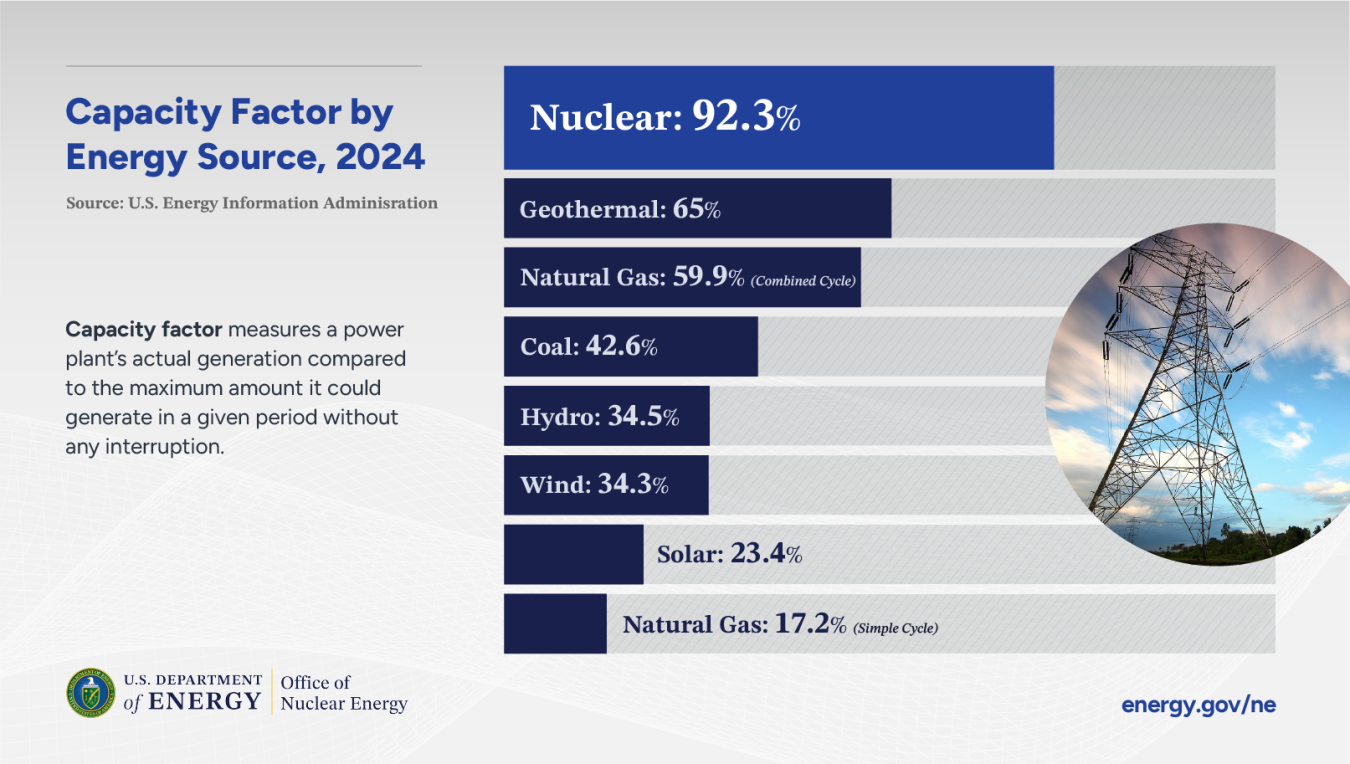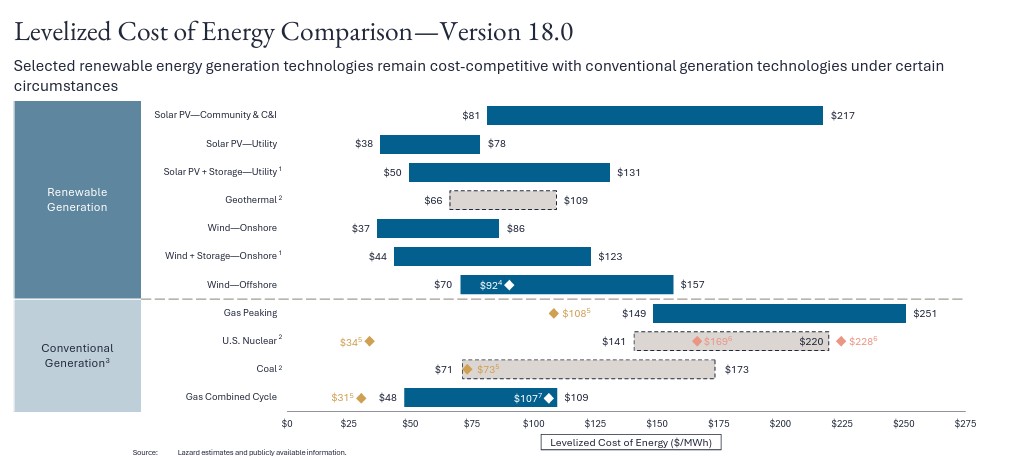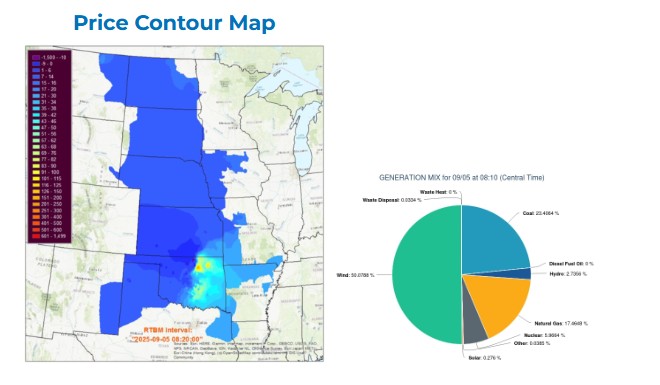TL;DR: Capacity factor is often misunderstood and misused against renewables. No power plant runs 100% all the time - coal, gas, and nuclear all experience downtime. Capacity factor measures how much a plant runs relative to its maximum potential, but it’s not the sole indicator of usefulness. Reliability and cost are what really matter. Renewables, despite lower capacity factors, are often the cheapest new sources of power. A diverse mix of resources makes the grid reliable, affordable, and increasingly powered by clean energy.
When I first started working on renewable energy issues more than 20 years ago, there weren’t helpful explainers, blogs, fact sheets, or really any easily accessible materials to learn about the fledgling industry. One of my first “a-ha” moments was when I figured out what “capacity factors” were for wind energy and solar power resources. I had always heard, and easily understood, that the wind didn’t always blow and the sun didn't always shine. So what happens when we need power and the wind doesn’t cooperate?
The first power concept to learn is what “nameplate capacity” is. Nameplate capacity is the term given for all power plants at 100% output. A 100 megawatt (MW) natural gas power plant (nameplate) would generate 100MW in one hour at 100% output. It should be intuitive, but a 300MW wind farm doesn’t perfectly replace a 300MW coal plant.
A typical wind turbine has a nameplate capacity rating of somewhere between 2 megawatts to maybe 5 megawatts. This has changed substantially since I first started in the industry - 20 years ago, a 1MW wind turbine was considered cutting edge. Now, those sizes are seen as babies. Wind turbines become larger over time to take advantage of economies of scale, to boost performance, and to reduce overall costs. So a 5MW wind turbine, at 100% output, would generate 5MW in an hour - or about the amount of power to run 2,500 homes for an hour.
But as we all know, and as the anti-renewables crowd loves to remind us, the wind doesn’t always blow. So how do we account for wind power variability, or any variability for any type of power plant?
This is where capacity factors come into play. Surprise! No power plant runs at 100% capacity factor 100% of the time. That’s simply not how electricity works. All power plants (even “baseload” power plants) require some form of maintenance and downtime. And in regions of the country with wholesale power markets, electric utilities and system operators like the Midcontinent Independent System Operator (MISO) and Southwest Power Pool (SPP) are constantly ramping power plants up and down to maintain power balance across the grid. So, even if a power plant has the capability of 100% output, it’s often fairly rarely required to reach that level.
As an example, think about a garden hose. The diameter of the hose is the capacity or nameplate capacity of the hose, while the variable amount of water flowing through the hose would be the capacity factor. A hose may be constructed to carry over 100 gallons of water per minute, but while it sits empty, the hose’s capacity factor has now become zero.
Different types of power plants have different average capacity factors. The Department of Energy (DOE) recently released some statistics showing that in 2024, the average capacity factor for the nuclear fleet was 92.3%, a very high rate. Still, reactors need downtime for refueling, maintenance, and in some instances, to prevent or respond to accidents. Some natural gas power plants have a capacity factor of around 60%. Last year, the average coal plant only ran about 43% of the time - mostly being supplanted by lower cost generation resources. Average wind farms across the country ran at about 34% capacity factor, with solar farms at about 23%.

Some anti-renewable activists just learning about the power industry find out about renewable power capacity factors and try to use this as a justification for hating clean energy resources. Their argument is that because capacity factors are low, that must mean that renewables aren’t useful, and instead it must mean nuclear is the best, for instance.
That’s not only a very rudimentary understanding of the power industry - it’s flat wrong.
The DOE reported that last year, simple cycle natural gas power plants had capacity factors of just 17% - worse than all other types of power plants. In fact, I’m sure you’d be able to find some natural power plants that only ran 1-2% last year.
Wait, what? Natural gas plants have extremely low capacity factors?
Well yes, some do. Some gas plants are known as “peakers” and are designed to turn on and off quickly, so they’re not used all that often. The power grid is constantly changing every minute, and utilities and grid operators have to ramp power plants up and down to respond to the power needs. The grid cannot operate on 100% baseload power plants. It needs power plants that are capable of ramping up and down to meet minute-by-minute changes in power demand.
If capacity factors were the only metric to use for picking and choosing winning technologies, nuclear would be the winner. So why isn’t it? Why is the grid a mix of technologies? Well, the grid is much more complicated than simply looking at capacity factors and writing off only certain generation technologies.
Think about your car. It has the capacity to reach 120 miles per hour (like a nameplate capacity rating), but you typically only use it between 30-60 MPH, or 25-50% capacity factor. If your car sits in the driveway, it’s at 0% capacity factor. If you were to add up all the hours of the year you use your vehicle, and the speed at which you drive it, then average it over all hours, you’d come up with an average annual capacity factor. Of course scientists have figured out that cars have a utilization rate of only about 5% of the time. Driving your car 2x as much doesn’t necessarily make each mile driven half as expensive - you’re racking up fuel costs and mechanical costs much quicker.
How do we determine whether power plants are useful or not, then?
Reliability and cost are the two most important metrics used in the industry. Reliability is the ability to serve power each hour of every day. It’s entirely possible to construct an extremely reliable power grid, but with costs so high that it would bankrupt any customer. Again, utilities, grid operators, and their regulators are constantly balancing the need for reliability, but also the affordability of the power systems. There are complicated models, forecasts, estimates, and constant reconfigurations to make the system work. This isn’t work you can do sitting at home Googling things and reading Facebook posts.
Both the reliability and the costs of the power system are influenced by capacity factors. A higher capacity factor typically reduces overall costs, but those costs are always relative to other generation technologies available.
For example: it may cost $15 billion for a 1,000 MW (nameplate) nuclear reactor, as the higher capacity factor, or output, you get from that plant will reduce the per-unit of energy cost of power from that plant. The fixed construction costs are spread over more operational hours. To put the various generation technologies on a more equal cost footing, the electric industry uses a metric called the Levelized Cost of Energy, or LCOE values.
LCOE equations take all the costs with generation technology to generate a certain amount of power, and with a capacity factor, figures out how much it would cost for one megawatt hour of electricity (MWh). It’s like taking the cost of a hose and figuring how much a gallon of water costs to be delivered. Or costs per mile driven in your car. Even without subsidies, renewable resources are often cheaper than just about any other new source of power plant.

Think about it this way - if your neighbor were to infrequently give you a box of veggies from their garden, that produce is very low cost to you, but it’s variable. Does that mean you should tell your neighbor to bug off when they offer you some fresh tomatoes? Absolutely not. Your neighbor’s capacity factor would be very low, but the cost is also very low. Alternatively, you could eat at restaurants for 100% of your meals, making restaurant capacity factors very high, but the cost would also be very high.
Now imagine what happens if you get a bunch of neighbors that each infrequently provides you with free or low cost veggies. All of a sudden, your restaurant expenditures would plummet, because you could/would likely start to depend on your neighbors’ generosity. That’s the concept around building more and more renewable resources. Sure, they’re variable, but if you build a lot, that variability becomes fairly predictable and well understood.
On the morning of September 5, more than 19 million people in Southwest Power Pool’s territory received 50% of all their electricity from wind farms. That’s happening more and more often, too.

So the next time someone says something about renewable capacity factors being low, you’re free to throw a tomato at them.


